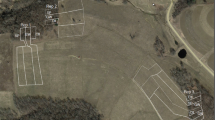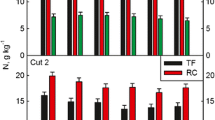Abstract
In 1984, five silvipasture treatments of native grasses (NG), Au-Lo-Tan lespedeza (L), bahiagrass (B), common bermudagrass (CM), and Coastal bermudagrass (CB), were established in a thinned 20-year-old loblolly pine plantation. Pine growth data were collected in 1984, 1987, and 1989. From 1986 to 1988, annual forage production was evaluated at 21-day intervals from April to October with forage dry matter yield and quality determined for each sampling interval. Forage management improved timber production with 5-year lumber growth on the NG, B, CM, and CB treatments exceeding the untreated plantation by 5.4 m3 ha−1. Forage protein content, IVDMD, and P levels did not differ among treatments but daily dry matter yield did (p=0.05). Mean 3-year daily dry matter yields were 7.4, 5.9, 12.3, 8.3, and 18.5 kg ha−1 for NG, L, B, CM, and CB. Financial comparison of a CB open pasture with a CB silvipasture showed that the silvipasture internal rate of return exceeded the CB open pasture by 7.3%. A loblolly pine-forage intercropping system is a suitable management option for maturing plantations.
Similar content being viewed by others
References
Association of Official Agricultural Chemist (1960) Official Methods of Analysis, 9th edition, pp 367–385. Washington, DC
Bond WE and Campbell RS (1951) Planted pines and cattle grazing. Louisiana Forestry Comm Bull 4, 28 pp
Clason TR and Oliver WM (1984) Timber-pastures in loblolly pine stands. In: Johnson MK (ed) Proc 33rd Annual LSU Forestry Symposium, pp 127–137. School of Forestry and Wildlife Management, LSU, Baton Rouge, LA
Eichhorn MM, Nelson BD, Montgomery CR, Kowalczuk JG, Harrel AT and Devold L (1983) Yield and nutritive value of coastal, coastcross-1, alicia, and common bermudagrasses. La Agri Exp Stn Bull 757, 19 pp
Hughes RH, Hillmon JB and Burton GW (1965) Improving forage on southern pine woodlands. USDA SE For Exp Stn Series Paper No 146, 3 pp
Johnson MK and Davis LG (1982) Potentials for forest grazing in the Southeastern United States. Int Tree Crops J 7: 121–131
National Academy of Sciences (1984) Nurient Requirements of Beef Cattle, 6th edition. Washington, DC, 90 pp
Nelson BD, Montgomery CR, Schilling PE and Mason L (1976) Effects of fermentation time on in vivo/in vitro relationships. J Dairy Sci 59: 270–277
Shepherd WO, Southwell BL and Steveson JW (1953) Grazing longleaf-slash pinA Agr Circ 928, 31 pp
Southwell BL and Halls LK (1955) Supplemental feeding of range cattle in longleaf-slash pine forests of Georgia. J Range Manage 8: 25–30
Southwell BL and Hughes RH (1965) Beef cattle management practices for pine-wiregrass ranges of Georgia. Ga Agri Exp Stn Bull N S 129, 26 pp
Tilley JM and Terry RA (1963) A two-stage technique for in vivo digestion of forage crops. J Br Grassl Soc 18: 104
Wolters GL (1981) Timber thinning and prescribed burning as methods to increase herbage in grazed and protected longleaf pine ranges. J Range Manage 34: 494–497
Author information
Authors and Affiliations
Additional information
Approved for publication by the Director of the Louisiana Agricultural Experiment Station as manuscript number 93-80-7291.
Rights and permissions
About this article
Cite this article
Clason, T.R. Economic implications of silvipastures on southern pine plantations. Agroforest Syst 29, 227–238 (1995). https://doi.org/10.1007/BF00704870
Issue Date:
DOI: https://doi.org/10.1007/BF00704870




